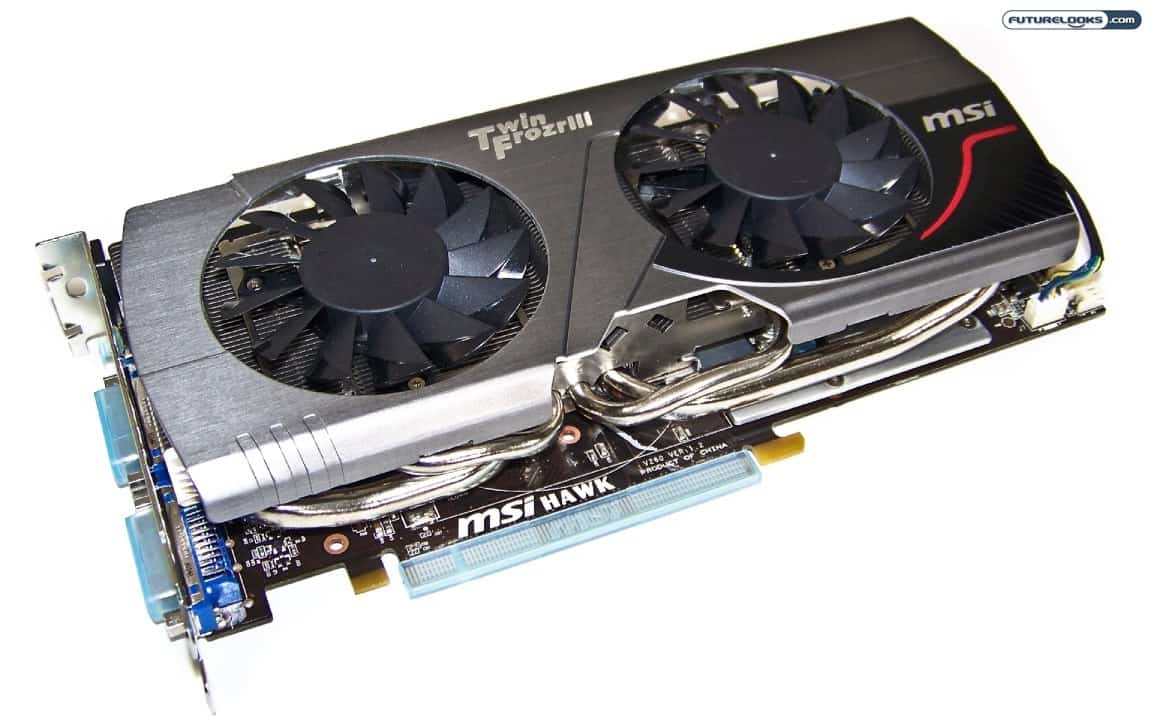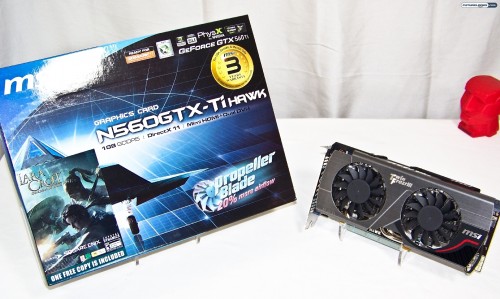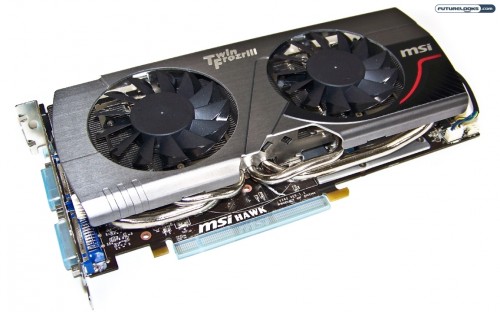MSI makes many different versions of their video cards. Some include their entry level Cyclone(II) cooler and minor tweaks while at the very top, there is the Lightning series which has many tweaks. Somewhere in the middle is where the “Hawk” makes its nest. MSI offers options for both AMD and NVIDIA fans at different performance levels to suit the budget and today we’ll be checking out their MSI N560GTX-Ti Hawk Edition based on the nVidia GTX 560 Ti GPU. We recognized the GPU as one of the best bang for buck graphics accelerators on the market. But what makes the Hawk so special? Read on and you’ll find out!
Features and Specifications
When you buy an MSI Hawk series video card, you’re getting higher clock frequencies and better components which is part of their “Military Class” standard. The result is a factory clocked (not overclocked) video card using some of the best GPUs in the bin. It creates a lean, mean, graphics rendering machine. The video below gives you our quick introduction of the HAWK series and what makes this different than their also impressive Twin Frozr II based version…
Sure, the GTX 560 Ti Hawk offers all of the latest NVIDIA visual features. But, it’s the higher GPU core and memory frequencies that separate it from the usual competition. It’s the Hawk Edition’s ability to overclock with additional voltage control that truly sets it apart. Taking it further are small voltage tuning leads for those that might be so included to do some extreme overclocking using LN2. Otherwise, higher temps caused by regular overclocking is kept under control with the revised heat pipes and cooler. Here’s how the HAWK stacks up to regular cards…
While you can’t easily tell the Hawk edition is fast just by looking at it, the frequency specifications make it obvious that it’s not just your regular GTX 560 Ti. The current pricing of the cards in the table also gives one cause to seriously consider the faster Hawk series over regular versions. At $264.99 US, that’s less than a $20 increase over its slightly slower sibling. Testing will tell us if that’s worth the extra cash.
Test System Setup
The test system is similar to our original GTX 560 Ti launch review, but has one change. We pulled the MSI P67A-GD65 motherboard to swap out with the B3 revision. Unfortunately, we haven’t been able to obtain a replacement under warranty. Thus, we’ll be using an ASUS SaberTooth P67 B3 motherboard for today’s review process. Here’s the breakdown of the other components:
- Processor: Intel Next Generation Core i7-2600K Sandy Bridge
- Motherboard: ASUS Sabertooth P67
- Memory: Kingston HyperX Genesis 4GB 2133MHz Dual Channel DDR3
- Graphics 1: NVIDIA GTX 560 Ti
- Graphics 2: MSI N560GTX-Ti TwinFrozr II
- Graphics 3: MSI N560GTX-Ti Hawk
- Graphics 4: MSI N460GTX TwinFrozr II
- Graphics 5: ZOTAC Geforce GTX 480
- Power Supply: Antec CP-850 PSU
- CPU Cooler: Zalman CNPS10X Extreme Silent Cooler
- Enclosure: Open Ended Tech Station
In this comparison, only the GTX 560 Ti cards were overclocked to see where the frequencies top out. You should understand that as your overclock your own video card, there is a risk of damaging your card. You also create more heat and noise in your system. Make sure you have plenty of cooling to start. Your results may vary. Let’s cook some GPUs!
Benchmark Suite and Notes
This time around, I’m leaning up the benchmark suite just a bit. Along with maxing out every video setting, we’re starting off with 3DMark11 then straight in to Batman: Arkahm Asylum (DX9), Mafia (DX9), Farcry 2 (DX10), Resident Evil 5 (DX10), Alien vs Predator (DX11), Metro 2033 (DX11), and STALKER: Pripyat (DX11).
Each video card’s operational temperature was monitored using MSI Afterburner. The GTX 560 Ti cards were also overclocked using MSI Afterburner keeping the core and memory linked. Video card fan noise was too low for most all of my sound meters set up at 3 feet away. Instead, noise was measured at 12″ from the cards just so we could get a reading. Now on with the testing!
The Hawk’s Overclocking Fury
MSI’s GTX 560 Ti series aren’t designed without a little something extra under the hood. In fact, their entry level card is actually an OC model and clocks in higher than the base model GTX 560-Ti. Yet, it still has some overclocking head room. To show you what that means, all three of the 560 Ti were overclocked using MSI’s Afterburner utility so you can see where the extra GPU quality comes into play.
The entry level NVIDIA Geforce GTX 560 Ti tried very hard to match the Hawk’s stock frequencies. But, like all overclocking, we wouldn’t recommend pushing these voltages 24-7 for months on end. And, yes, this is almost typical of any decent GTX 560 Ti card.
The biggest surprise came when the Twin Frozr II screamed passed its 880MHz core clear up to 1022MHz. Temps and noise were still very well managed. Again, we wouldn’t say do this for days on end as it could greatly diminish the lifespan and stability of the card long term.
Finally, the Hawk has even more overclocking left under that bigger VGA cooler and beefier heat pipes. It required near MAX voltage getting near 1080MHz core. The memory seemed to top out oddly on both cards at about 2320MHz. The core/shader frequencies are where the bulk of the performance is at and the results should prove to be interesting in the benchmarks.
Keep in mind that your overclocking results will vary. Here in the Seattle Lab, we use tech stations without extra cooling fans. Extra air flow may or may not help. However, if your computer case doesn’t have good air flow to begin with, heat will quickly cause stability and cooling issues. Just how hot these cards get will be covered after the benchmarks once we observe how well the cooling solutions perform.
3DMark11
Since MSI and 3DMark11 go hand in hand like Starbucks and WiFi, we have to start off the beatings (benchmarks) with the program. Give it a shot and see where you place at home.
In this benchmark, core/shader frequencies make all the difference. Coupled with some higher memory bit-rates, the GTX 480 out paces the rest of the pack. Still, you can see just how strong the MSI team is right up to the Hawk, which leads the GTX 560 Ti posse.
Batman: Arkham Asylum (DX9)
Many of today’s high performance video cards make easy work of DirectX 9 games. The Hawk comes very close to matching the performance of the GTX 480. If DX9 games are your forte, the Hawk is your best choice and Batman: AA is one great game with excellent replayability.
Mafia 2 (DX9)
Even though this is a DX9 title, it’s the maximum PhysX settings that favor the higher number of CUDA cores. Cards like the GTX 480 clearly command. That doesn’t make the Hawk look any less impressive though. Frequencies will benefit PhysX when there’s limited shader cores.
Farcry 2 (DX10)
In Farcry 2, while the Hawk reveals itself faster, it could just be a driver glitch that makes the GTX 480 look a few frames slower. Whatever the reason, we’ll take the frames we can get and will keep an eye on the GTX 480 in future tests.
Resident Evil 5 (DX10)
Similar to Farcry 2, the end result is a close battle between the GTX 560 Ti Hawk and GTX 480. It’s the Hawk’s high frequencies that once again give this card its competitive edge over its siblings. There are no issues at all running DX10 games either in this round.
Alien vs Predator (DX11)
Maxing out the settings in this benchmark will show you immaculate Tessellation (DX11) details. The Hawk card practically keeps up with the GTX 480. Some of that probably has to do with optimizations in the newer core, but can also mean that this title prefers higher clock speeds over number of shaders.
Metro 2033 (DX11)
This game is such a resource hog at higher resolutions, it’s not even worth tweaking to reach playable frame rates. Still, the raw GPU power of the Hawk shows the colors of its feathers. If you happen to overclock your CPU a bit, you’ll see frame rates that top the GTX 480 easily.
STALKER: Pripyat (DX11)
STALKER is a really cool game for benchmarking video cards. The game is so detailed, it uses just about every possible resource inside each of the video cards. Even though we’re using the maximum possible settings, the Hawk (and TwinFrozr II) provide extremely playable frame rates even at stock frequencies.
Evaluating GPU Temps and Fan Noise
In order to get a good overall average range of idle and gaming temperatures, we used the Hardware Monitor inside MSI’s afterburner software to confirm and monitor our results. We recorded idle and benchmark temperatures.
Even though the Hawk series card clocks in higher while consuming slightly higher wattage, the card was actually very comparable to the TwinFrozr II card in terms of performance. While the Hawk runs a more efficient GPU, it’s obvious that the improved VGA cooler is able to help manage temps whether overclocked or not. It was nice to experience great stock and overclocked frame rates without topping 80C or being subjected to higher noise.
Final Thoughts
Does the GTX 560 Ti Hawk Soar? Our MSI N560GTX-Ti Hawk series video card not only clocks in higher, but overclocks well beyond any stock card’s abilities. The stock 950MHz GPU core provides comparable frame rates to the GTX 480 in many of our benchmarks. However, being able to clock the GPU core clear up 1050MHz using auto voltage settings with MSI’s Afterburner software is an impressive feat.
At the current MSRP of $264.99 from various retailers, the MSI N560GTX-Ti Hawk Edition is lethal against the competition. It has the heart of a frame rate killer and it includes a Lara Craft game title to add some value. There are quite a few GTX 560 Ti cards with special aftermarket cooling that come very close to this price and yet they have much lower out of box frequencies. That makes the Hawk all the more enticing.
Ultimately, the MSI N560GTX-Ti Hawk is worth every dollar. Both the Twin Frozr II and Hawk make it very hard for other solutions to measure up. Based on the great value, exceptional performance, and great aftermarket cooling solution, we believe that it deserves out highest honor: An Editors’ Choice award.
Pros
- Superb performance and overlocking
- Great VGA cooling solution
- High quality components and design
- Includes a game title
- MSI Afterburner overclocking utility
- Excellent value for price
Cons
- They only sent me one!
Overall Rating: 9.5 / 10.0
Love This Review? Hate This Review? Leave a Comment Below!




